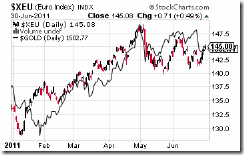Amazing, the Philippine Phisix simply shrugged off the US-European market rout yesterday.

Chart from technistock.net
The actions of the market can’t be argued as having been boosted from US Federal Reserve assurances as alleged by some, for the following reasons:
One, the Phisix opened down only less than 2% (81.47 points). This represents evidence that even with heightened uncertainty overseas, investors put an immediate floor on the Phisix from the opening bell.
Two, Japan’s Nikkei is still down more than 1% as of this writing. This hardly means Fed assurance factor.
Three, except for Indonesia which is down about 1%, Malaysia and Thailand are slightly lower. In other words, today's action is another validation of the ASEAN divergence process at work.
Fourth, the mining issues spearheaded this magnificent intraday recovery.

The mining index surged by 4.2% and carried the weight of the Phisix rebound!
Nevertheless, the big picture tells us that the Fed’s (stealth QE) and the ECB’s QE may have been interpreted by the world markets as an antidote with insufficient potency to overwhelm the prevailing negative factors
Second, the Eurozone’s crisis continues to affect global markets
And that’s why Ben Bernanke came out last night swinging at the notion that dissensions from within the ranks of the US Federal Reserve board of governors would stop him from declaring another round of overt Quantitative Easing.
We will see.
In my view, I believe that despite today's superb performance by the Phisix, caution is highly warranted until we see:
-concrete or definitive actions by the US Federal Reserve. Again, stealth QE by the Fed and the ECB’s overt QE has been essentially eclipsed or overpowered by the banking-PIIGS meltdown in Eurozone.
-signs of stability in global equity markets (where large swings or gyration dissipates), even if most of the world markets continue to decline.
Though yes, $1,800 gold appears to be lending support to the Phisix as I have been arguing here.
Just to show how the Phisix-ASEAN seems to metaphorically defy gravity, this great year to date chart is from the Bespoke Invest is telling.

As of yesterday, of 78 nations monitored by Bespoke Invest, there are only 10 gainers so far.
Two of them hails from ASEAN, particularly Thailand and Indonesia. The Philippines (12th) and Malaysia (14th) are still ranked in the top 20 of the world's best performers despite marginal losses.
The US is ranked 19th in spite of the series of recent blood bath.
If you look at the overall performance, one would note that global equities have mostly been in the sea of red, with more countries joining the ranks of bear market losses (20% or more) rather than of the gainers’ column.
Such broadening losses should be seen as a source of caution, nevertheless, cautious optimism.










































